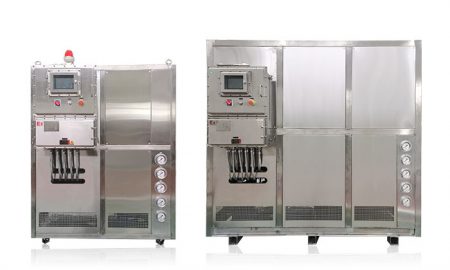Heater Chiller
Heater chiller is also called high and low temperature all-in-one machine, refrigeration heating temperature control system, etc. in the industry. Different manufacturers may call it differently, but the functions of this type of equipment are similar. They are routinely used in supporting reaction kettles in the pharmaceutical and chemical industries. To provide the temperature requirements for heat absorption and heat release.
First, the application introduction of heater chiller
1. The heater chiller can be equipped with reactors, reactors, extraction equipment, rotary evaporators and other instruments to increase and decrease different temperatures, and provide endothermic and exothermic reactions. Users can use explosion-proof reactors to achieve their needs. The temperature range supported by our equipment is -120°C~350°C.
2. The heater chiller can provide accurate temperature process control. It can be equipped with one reactor or multiple reactors for cooling, heating and temperature control. Using a closed circulation pipeline system, water vapor will not be absorbed during low-temperature reactions, and high-temperature reactions will not Oil mist will be generated, which can realize connection temperature rise and fall control within a certain range.
Second, precautions for heater chiller
1. Read the instruction manual before using the heater chiller, and have a certain understanding of the appearance and configuration of the equipment;
2. Turn on the power of the heater chiller, and set it according to the circuit requirements in the manual;
3. The switch of the heater chiller can be set separately and connected in parallel in the circuit to ensure that the shutdown of other equipment circuit failures will not affect the use of the equipment;
4. Check the tightness of the connecting pipeline interface between the heater chiller and supporting equipment;
5. When the heater chiller is connected to supporting equipment, care should be taken to avoid air bubbles remaining in the system, to ensure that the outlet of the heat transfer medium is connected to the lower interface of the reactor, and the inlet of the heat transfer medium is connected to the upper interface of the reactor;
6. When filling the heat transfer oil, you need to pay attention to the type of heat transfer oil. Different models have different temperature requirements. The temperature range of the heater chiller should match the temperature range of the heat transfer oil;
7. When the heater chiller is filled with heat-conducting medium, care should be taken to prevent the heat-conducting medium from overflowing to the upper cover plate, and the liquid overflowing to the upper cover plate may cause the heat-conducting medium to leak into the electrical components of the equipment, which may cause equipment failure;
8. When the temperature control effect of the equipment is not satisfactory, the user can perform system self-tuning. During the self-tuning process, the temperature will have a large overshoot, and the user should fully consider this factor before performing the system self-tuning;
9. After the heater chiller is filled with heat transfer medium and exhausted, it can start to control the temperature. After setting the temperature, press the circulation button and the refrigeration button (the circulation pump must be kept working when the equipment is running, otherwise it will cause system error). When the temperature reaches the set value, the refrigeration will be automatically turned off, and the refrigeration compressor will be turned on after the temperature rises;
Heater chiller is a kind of equipment that integrates heating, high temperature and cooling technology of cooling, heating and temperature control. During use, you need to use and maintain your product correctly, so that the equipment can be kept in good operating condition and exert high-quality temperature control effect.
Maßgeschneiderte Lösungen für Ihr Unternehmen

Kühl- und Heizsysteme (Serie SUNDI)
Temperaturregelbereich: -120°C bis +350°C
Anwendung: Verschiedene Reaktoren (Mikrokanäle, Glas, ummantelte Reaktoren usw.), Destillations- oder Extraktionssysteme, Labor, Universität, Forschungsinstitut, Luft- und Raumfahrt, Automobilindustrie, Halbleiter- und Elektrotests, Chemie, Pharmazie, Petrochemie, Biochemie, Medizin, Krankenhaus, F&E-Werkstatt, Luft- und Raumfahrt, Biologie und andere Industrien.
| Temperaturbereich | Serie -40 ~ +200°C | Serie -10 ~ +200°C | Serie -25 ~ +200°C | Serie -25 ~ +300°C | Serie -45 ~ +250°C | Serie -45 ~ +300°C | Serie -60 ~ +250°C | Serie -60 ~ +300°C | Serie -70 ~ +250°C | Serie -80 ~ +250°C | Serie -90 ~ +250°C | Serie -100 ~ +100°C | -25 ~ +200°C eine Maschine für zwei Reaktoren | -40 ~ +200°C eine Maschine für zwei Reaktoren |
| Kühlleistung | bis zu 3kW | bis zu 15kW | bis zu 200kW | bis zu 200kW | bis zu 200kW | bis zu 25kW | bis zu 60kW | bis zu 25kW | bis zu 15kW | bis zu 80kW | bis zu 80kW | bis zu 80kW | bis zu 10*2kW | bis zu 10*2kW |

Kühl- und Heizsysteme (WTD-Serie)
(Mikrokanal / Röhrenreaktoren spezialisiert)
Temperaturregelbereich: -70°C bis +300°C
Spezielles Design für Mikrokanäle (geringe Flüssigkeitsspeicherkapazität, starke Wärmeaustauschkapazität, Zirkulationssystem mit hohem Druckabfall)
| Temperaturbereich | -70°C ~ +300°C | -45°C ~ +250°C | -70°C ~ +200°C |
| Kühlleistung | bis zu 7,5 kW | bis zu 5,5 kW | bis zu 50kW |

Kühl- und Heizsysteme (TES-Serie)
Temperaturregelbereich: -85°C ~ +250°C
Temperaturregelungsgenauigkeit: ± 0,3°C
| Temperaturbereich | Serie -45°C ~ +250°C | Serie -85°C ~ +200°C | Serie -60°C ~ +200°C |
| Kühlleistung | bis zu 25kW | bis zu 25kW | bis zu 60kW |

Kühl- und Heizmaschinen (LTS-Serie)
Temperaturregelbereich: -80°C bis +80°C
Es wird häufig in der Halbleiterindustrie eingesetzt, um die Temperatur der Reaktionskammer, der Heizplatte und des nicht brennbaren Wärmeträgers zu regeln.
| Temperaturbereich | -20°C ~ +80°C Reihe | Serie -45°C ~ +80°C | Serie -60°C ~ +80°C | Serie -80°C ~ +80°C |
| Durchflusskontrolle | 7 ~ 45 L/min | 7 ~ 45 L/min | 7 ~ 45 L/min | 7 ~ 45 L/min |

Umwälzpumpen für Kühlung und Heizung
Temperaturregelbereich: -45°C bis +250°C
Anwendung: Verschiedene Reaktoren (Mikrokanäle, Glas, ummantelte Reaktoren usw.), Destillations- oder Extraktionssysteme, Labor, Universität, Forschungsinstitut, Luft- und Raumfahrt, Chemie, Pharmazie, Petrochemie, Biochemie, Medizin, Krankenhaus, F&E-Werkstatt, Luft- und Raumfahrt, Biologie und andere Industrien.
| Temperaturbereich | Serie -25°C ~ +200°C | Serie -45°C ~ +250°C |
| Kühlleistung | bis zu 15kW | bis zu 15kW |

Heizungsumwälzpumpen
Temperaturregelbereich: +50°C bis +300°C
Hinweis: Die UC-Serie kann die Temperatur des Wärmeträgermediums regeln. Die UST-Serie kann nicht nur die Temperatur des Wärmeträgermediums, sondern auch die Temperatur des Reaktionsmaterials regeln.
| Temperaturbereich | +50°C ~ +200°C (UC-Serie) | +50°C ~ +300°C (UC-Serie) | +50°C ~ +300°C (UST-Serie) |
| Heizleistung | bis zu 38kW | bis zu 200kW | bis zu 95 kW |

TCU Multireaktoren Temperaturkontrollsystem
Temperaturregelbereich: -120°C bis +250°C
Anwendung: Verschiedene Reaktoren (Mikrokanäle, Glas, ummantelte Reaktoren usw.), Destillations- oder Extraktionssysteme, Labor, Universität, Forschungsinstitut, Luft- und Raumfahrt, Chemie, Pharmazie, Petrochemie, Biochemie, Medizin, Krankenhaus, F&E-Werkstatt, Luft- und Raumfahrt, Biologie und andere Industrien.
| Temperaturbereich | Serie -45°C ~ +250°C | -120°C ~ +250°C Reihe | Kundenspezifisches Temperaturkontrollsystem | RT+10°C ~ +135°C |
| Heizleistung | bis zu 80kW | bis zu 80kW | Benutzerdefiniert | bis zu 300kW |
 LNEYA
LNEYA
 简体中文
简体中文

















































































